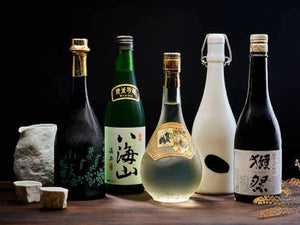
Sake Serving Temperature Names
Sake Serving Temperatures
Sake serving temperature is not just cold, warm, or room temperature. It's much more nuanced with 10 distinct names for different sake serving temperatures.
Temperature Guide
- 55℃/131℉ Tobikiri-Kan (飛びきり燗): Hot. Very strong in flavor, becomes super-dry.
- 50℃/122℉ Atsukan (熱燗): Slightly hot. Sharp flavors. Dry texture.
- 45℃/113℉ Jo-Kan (上燗): Warm. Steam puffs out when sake is poured into a glass.
- 40℃/104℉ Nuru-Kan (ぬる燗): Close to body temperature. Moderately warm. Aromas open up the most. Mild flavor.
- 35℃/95℉ Hitohada-Kan (人肌燗): A bit lower than body temperature. Slightly warm. Aromas of rice and Koji become rich.
- 30℃/86℉ Hinata-Kan (日向燗): Neither warm nor cold. Aromas open up. Smooth texture.
- 18-28℃/64-82℉ Hiya (冷や): Room temperature. The original flavors and aromas can be enjoyed as they are.
- 15℃/59℉ Suzu-hie (涼冷え): Fragrant aromas. Thick texture.
- 10℃/50℉ Hana-hie (花冷え): Kept in the fridge for a few hours. Clean.
- 5℃/41℉ Yuki-hie (雪冷え): Very cold. Aromas close up. Clean texture can be enjoyed.
Which Names are Popular in Japan?
Only sake enthusiasts typically know all ten names. Many Japanese don't know them all. Here are the more common terms:
- Atsukan: Often refers to ‘Hot Sake’ in general, though it specifically means 55℃/131℉.
- Nurukan: Popular with enthusiasts. Not as hot as Atsukan, but still warm.
- Hitohada Kan: Similar to Nurukan and popular among enthusiasts. Indicates a good understanding of sake.
- Hiya: Refers to room temperature. Misunderstood by many Japanese as ‘cold sake’ due to the literal meaning of ‘Hiya’ (冷や).
Understanding 'Hiya'
Originally, there was no cold sake, only hot and room-temperature sake. With the advent of refrigerators, cold sake emerged, but 'Hiya' originally meant room temperature. To avoid confusion, 'Jouon' is the safest term for room-temperature sake.
How to Order Hot and Cold Sake in Japan
When dining out in Japan, you often have two choices: hot or cold sake. Here’s how to order:
- Cold Sake: Reishu (冷酒). Some use Hiya (冷や), but it traditionally means room temperature.
- Hot Sake: Okan / Kanshu / Atsukan (お燗/燗酒/熱燗). Atsukan is specifically 55℃/131℉, but is often used to refer to hot sake in general.
- Room Temperature: Jouon (常温). Hiya is controversial, as explained above.
Even if room temperature sake isn't listed on the menu, you can request it from the waiter to enjoy the sake's true flavors.
Why Does Sake Serving Temperature Range from 5℃ to 55℃?
The minimum temperature for sake is 5℃/41℉ because lower temperatures would freeze the sake. The maximum is 55℃/131℉, as higher temperatures cause evaporation, diminishing flavors and aromas.
Take It Simple
Sake, like wine, can be enjoyed chilled or warmed depending on its body and flavor profile. However, personal preferences, moods, and climate play a significant role. Experiment with different temperatures to find your favorite way to enjoy sake!

